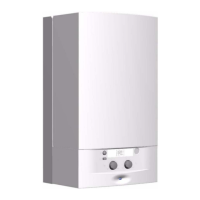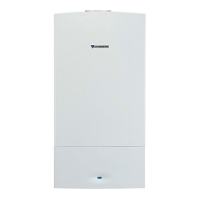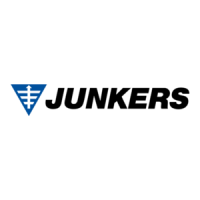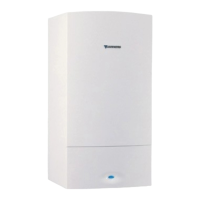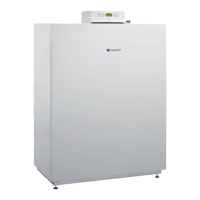Do you have a question about the Junkers Cerapur 9000i and is the answer not in the manual?
Details warning symbols, signal words, and other icons used in the manual.
Provides essential safety guidelines for installation, commissioning, and maintenance personnel.
Information regarding safe and professional installation, commissioning, and maintenance.
Details product compliance with European directives and national requirements.
Lists the different models of the Cerapur 9000i boiler and their item numbers.
Describes the information found on the product's nameplate.
Lists the components included in the boiler package.
Describes the automatic pump activation to prevent seizing during long periods of inactivity.
Information on available accessories for the devices.
Provides diagrams and measurements for device dimensions and connections.
Technical data tables detailing performance, emissions, and electrical specifications.
Refers to the user manual for energy consumption product data.
Diagrams illustrating the residual head generated by the internal heating pump.
Table listing the composition of condensate and associated values.
Highlights the need to observe national and regional regulations for installation and operation.
Covers notification and permit requirements for gas supply and condensate disposal.
States that updated regulations are also valid at the time of installation.
Safety warning about proper lifting techniques to prevent injury and damage.
Instructions on how to unpack the device and handle packaging materials.
Critical safety warning regarding work on gas-carrying parts.
Guidance on water quality for filling and topping up the heating system.
Steps for connecting heating water pipes, including maintenance taps and seals.
Detailed instructions for connecting heating water pipes, including filter and service cocks.
Guidance on checking if the 15L expansion vessel is sufficient for the system.
Notes on the safety valve, stating no on-site overflow valve is needed.
States that a bypass in the heating system is not required.
Important notes regarding connections for external hot water storage tanks.
Guidance on connecting the flue gas line and references to accessory instructions.
Important safety warnings and general remarks about electrical connections.
Instructions for connecting various accessories to the terminal strips.
Instructions for connecting a second function module using EMS bus and mains cable.
Instructions for connecting a temperature monitor for underfloor heating systems.
How to connect the outside temperature sensor to the control system.
Connecting the cylinder temperature sensor to the designated terminal.
Information on using 230V connections for electrical accessories and power limits.
Instructions for connecting an external heating pump.
How to connect the circulation pump for control by the system.
Connecting the storage tank charging pump or external 3-way valve.
Connecting an external 3-way valve when the internal one is absent.
Step-by-step guide to filling the heating system with water and bleeding it.
Instructions on how to switch on the device after installation.
Explanation of the automatic siphon filling mode and its conditions.
Procedures for checking gas connection pressure and other measurements.
Procedure for setting the gas-air ratio using CO2 or O2 measurement.
Instructions for setting the gas-air ratio via CO2/O2 measurement and nozzle adjustment.
Procedure for setting overpressure operation and adjusting minimum heat output.
Information and warnings regarding thermal disinfection to prevent legionella.
Checks for regulation, control, and safety devices during commissioning.
Steps for reassembling the device after maintenance and filling out reports.
Instructions for reading and changing hot water temperature settings.
Instructions for reading and changing boiler temperature settings.
Guidance on operating the device manually or in emergency mode.
How to access and navigate the device's settings menu.
How to read device status information such as boiler temperature and pressure.
Describes how the display sleeps and how to exit idle status.
Warning about system damage from frost and ensuring continuous operation.
Steps to safely shut down the heating system via the device controls.
Instructions on navigating menus and selecting items.
Steps to select and save new values within the menu system.
Overview of the service menu structure and available parameters.
Settings related to heating capacity, lock time, and temperature differences.
Settings for pump control, soft temperature, and boiler pump.
Settings for pump map and pressure control modes.
Setting minimum pump performance at minimum heat output.
Setting maximum pump performance at maximum heat output.
Sets the run-on time for the pump after heat request.
Configuration for maximum hot water output and thermal disinfection.
Settings for circulation pump operation, including frequency.
Configuration for ventilation function (power off, always on, once).
Ensures the system is drained and the engine can be removed.
Defines limits for heating capacity, hot water output, and flow temperature.
Enables testing of ignition, fan, pump, and 3-way valve functions.
Options to reset the heat generator or basic settings.
Adjustments for language, display turn-off, brightness, and contrast.
Information on environmentally friendly and recyclable packaging materials.
Guidance on recycling old devices and their components.
Crucial safety warnings for electrical shock, gas leaks, and water damage.
How to view the last saved fault in the service menu.
Procedure for checking, cleaning, and replacing electrodes.
Instructions for visually checking gas and water pipes for corrosion.
Procedure for cleaning and refilling the condensate siphon.
Steps to activate and check heating and hot water requests.
Instructions for checking and cleaning the heating block, including pressure checks.
A comprehensive checklist for performing regular inspection and maintenance tasks.
Describes the displays that signal operating states during normal operation.
Explains how faults are indicated and how to exit fault displays.
A table listing fault codes, descriptions, and elimination steps.
Lists potential issues that do not trigger a fault display and their causes.
Advice to contact the manufacturer for additional information.
Contact details for Bosch Thermotechnik GmbH Junkers Germany.
Contact details for Robert Bosch AG Thermotechnology division in Austria.
Contact details for Tobler Haustechnik AG in Switzerland.
Details warning symbols, signal words, and other icons used in the manual.
Provides essential safety guidelines for installation, commissioning, and maintenance personnel.
Information regarding safe and professional installation, commissioning, and maintenance.
Details product compliance with European directives and national requirements.
Lists the different models of the Cerapur 9000i boiler and their item numbers.
Describes the information found on the product's nameplate.
Lists the components included in the boiler package.
Describes the automatic pump activation to prevent seizing during long periods of inactivity.
Information on available accessories for the devices.
Provides diagrams and measurements for device dimensions and connections.
Technical data tables detailing performance, emissions, and electrical specifications.
Refers to the user manual for energy consumption product data.
Diagrams illustrating the residual head generated by the internal heating pump.
Table listing the composition of condensate and associated values.
Highlights the need to observe national and regional regulations for installation and operation.
Covers notification and permit requirements for gas supply and condensate disposal.
States that updated regulations are also valid at the time of installation.
Safety warning about proper lifting techniques to prevent injury and damage.
Instructions on how to unpack the device and handle packaging materials.
Critical safety warning regarding work on gas-carrying parts.
Guidance on water quality for filling and topping up the heating system.
Steps for connecting heating water pipes, including maintenance taps and seals.
Detailed instructions for connecting heating water pipes, including filter and service cocks.
Guidance on checking if the 15L expansion vessel is sufficient for the system.
Notes on the safety valve, stating no on-site overflow valve is needed.
States that a bypass in the heating system is not required.
Important notes regarding connections for external hot water storage tanks.
Guidance on connecting the flue gas line and references to accessory instructions.
Important safety warnings and general remarks about electrical connections.
Instructions for connecting various accessories to the terminal strips.
Instructions for connecting a second function module using EMS bus and mains cable.
Instructions for connecting a temperature monitor for underfloor heating systems.
How to connect the outside temperature sensor to the control system.
Connecting the cylinder temperature sensor to the designated terminal.
Information on using 230V connections for electrical accessories and power limits.
Instructions for connecting an external heating pump.
How to connect the circulation pump for control by the system.
Connecting the storage tank charging pump or external 3-way valve.
Connecting an external 3-way valve when the internal one is absent.
Step-by-step guide to filling the heating system with water and bleeding it.
Instructions on how to switch on the device after installation.
Explanation of the automatic siphon filling mode and its conditions.
Procedures for checking gas connection pressure and other measurements.
Procedure for setting the gas-air ratio using CO2 or O2 measurement.
Instructions for setting the gas-air ratio via CO2/O2 measurement and nozzle adjustment.
Procedure for setting overpressure operation and adjusting minimum heat output.
Information and warnings regarding thermal disinfection to prevent legionella.
Checks for regulation, control, and safety devices during commissioning.
Steps for reassembling the device after maintenance and filling out reports.
Instructions for reading and changing hot water temperature settings.
Instructions for reading and changing boiler temperature settings.
Guidance on operating the device manually or in emergency mode.
How to access and navigate the device's settings menu.
How to read device status information such as boiler temperature and pressure.
Describes how the display sleeps and how to exit idle status.
Warning about system damage from frost and ensuring continuous operation.
Steps to safely shut down the heating system via the device controls.
Instructions on navigating menus and selecting items.
Steps to select and save new values within the menu system.
Overview of the service menu structure and available parameters.
Settings related to heating capacity, lock time, and temperature differences.
Settings for pump control, soft temperature, and boiler pump.
Settings for pump map and pressure control modes.
Setting minimum pump performance at minimum heat output.
Setting maximum pump performance at maximum heat output.
Sets the run-on time for the pump after heat request.
Configuration for maximum hot water output and thermal disinfection.
Settings for circulation pump operation, including frequency.
Configuration for ventilation function (power off, always on, once).
Ensures the system is drained and the engine can be removed.
Defines limits for heating capacity, hot water output, and flow temperature.
Enables testing of ignition, fan, pump, and 3-way valve functions.
Options to reset the heat generator or basic settings.
Adjustments for language, display turn-off, brightness, and contrast.
Information on environmentally friendly and recyclable packaging materials.
Guidance on recycling old devices and their components.
Crucial safety warnings for electrical shock, gas leaks, and water damage.
How to view the last saved fault in the service menu.
Procedure for checking, cleaning, and replacing electrodes.
Instructions for visually checking gas and water pipes for corrosion.
Procedure for cleaning and refilling the condensate siphon.
Steps to activate and check heating and hot water requests.
Instructions for checking and cleaning the heating block, including pressure checks.
A comprehensive checklist for performing regular inspection and maintenance tasks.
Describes the displays that signal operating states during normal operation.
Explains how faults are indicated and how to exit fault displays.
A table listing fault codes, descriptions, and elimination steps.
Lists potential issues that do not trigger a fault display and their causes.
Advice to contact the manufacturer for additional information.
Contact details for Bosch Thermotechnik GmbH Junkers Germany.
Contact details for Robert Bosch AG Thermotechnology division in Austria.
Contact details for Tobler Haustechnik AG in Switzerland.
| Modulation Range | 1:10 |
|---|---|
| Display | Touchscreen |
| Category | Boiler |
| Fuel Type | Natural Gas |
| Efficiency | 94% |
| Smart Home Compatibility | Yes |
